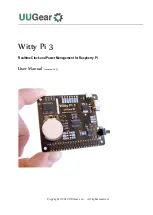
8/14
ASAC-1
5
Troubleshooting
5.1
Feedback LEDs
LED Status
Ready
Run
Off
No control power
Motor not running
On
Ready
Motor running at full speed
Flash
Starter tripped
Motor starting or stopping
5.2
Trip Codes
The Ready LED will flash a different number of times to indicate the cause of the trip.
Ready LED
Description
x 1
Power Circuit: Check mains supply (L1, L2, L3), motor circuit (T1, T2, T3), soft starter SCRs and bypass relays.
x 2
Excess Start Time: Check load, increase Current Limit or adjust Excess Start Time setting.
x 3
Motor Overload: Allow motor to cool, reset soft starter and restart.
The soft starter cannot be reset until the motor has cooled.
x 4
Motor Thermistor: Check motor ventilation and thermistor connection B4, B5. Allow motor to cool.
x 5
Current imbalance: Check for mains supply or line current imbalance (L1, L2, L3).
x 6
Supply Frequency: Check mains voltage is available and supply frequency is in range.
x 7
Phase sequence: Check for correct phase sequence.
x 8
Network Communication Failure (between module and network): Check network connections, settings and
configuration.
x 9
Starter Communication Failure (between starter and module): Remove and refit accessory module.
x 10
Bypass Overload: Starter rating may be too low for the application.
5.3
Protections
The ASAC-1 includes the following types of protection for the motor and starter:
5.3.1
Excess Start Time Protection
The ASAC-1 will trip on excess start time if the motor does not successfully start within the time selected in the Excess Start Time
setting. This may indicate that the load has stalled.
If the soft starter frequently trips on excess start time:
•
check that the Current Limit setting is high enough for the application
•
check that the Excess Start Time setting is long enough for the application
•
check that the load has not stalled or increased since the soft starter was installed
5.3.2
Motor Overload Protection
The ASAC-1 will trip on motor overload if it calculates that the motor has been running above its operating range for longer than the time
selected in the Motor Trip Class setting. Motor Trip Class should be set to match the motor's locked rotor time. If this information is
not available from the motor datasheet, use the default setting (Motor Trip Class = 10). Using a higher setting can damage the motor.
NOTE
Motor overload protection does not protect the soft starter, and does not protect the motor from short circuit.
1
4
2
4
3
.A
Ready
Run
Ready
Run
Reset
35 0 %
9 0 %
8 0 %
70 %
6 0%
40 0 %
30 0 %
50 %
1 0 0 %
16 s
8 s
1 2 s
1 0 s
No
S of t Sto p
4 5 0 %
2 5 0 %
6 s
4 s
2s
14 s
20 s
1 6
8
1 2
10
O F F
6
4
2
1 4
2 0
1 6
8
12
10
OF F
T RI P
RU N
F WD
F W D
AN Y
AN Y
6
4
2
5s
2 s
1 5s
5 s
O F F
15 s
5 s
2 s
2 s
1 5 s
4
2
1 4
20
Summary of Contents for ASAC-1 Series
Page 14: ...14 14 ASAC 1 ...
































